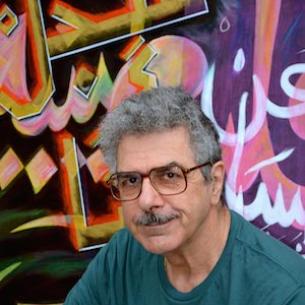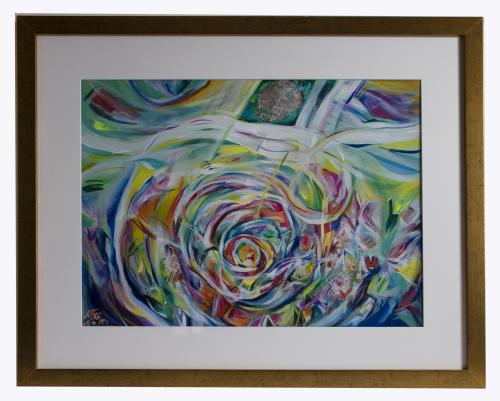
The Palestinian-Syrian Visual Arts Researcher and Critic wrote:
The Palestinian visual artist “Vladimir Tamari” was born in the old city of Jerusalem in 1942. He belongs to a Palestinian family that loves arts and science and excelled in these fields. In addition to Vladimir, his family included a number of artistic talents presented in his first sister “Vira Tamari” who is known in the fields of visual arts and issues related to Palestinian cultural heritage. His second sister “Tania Tamari Naser” excelled in the fields of music, heritage and singing. The family moved to live in Yafa before the great Palestinian catastrophe of 1948. Later, Vladimir was displaced from his homeland and ended up in the Lebanese city, Beirut. Beirut was his first refuge location outside his homeland Palestine.
Beirut formed a life and academic incubator for the Artist. He continued in academic education in the field of physical sciences in the American University of Beirut between the years 1957-1963. Later on, he continued his academic education in the fields of visual arts in St. Martin Academy in London. At that time, he was able to study classic Arabic calligraphy with which the different copies of the Holy Quraan were written. After completing his study in this field, he was able to come out with an invention in the field of calligraphy, which was registered in his name and was registered as a patent for inventing a printed Arabic letter that he named “AlQuds (Jerusalem)” in reference to his beloved city to which he belongs. At the beginning of his career life, Vladimir Tamari worked as a teacher in the schools of the UNRWA in Lebanon as a teacher of Arts Education and an artist who drew illustrative teaching aids. He also designed a device for 3D drawing. Furthermore, he participated in directing a number of artistic movies and books, including a documentary about Jerusalem in 1967.
In 1970, Vladimir Tamari left Beirut and headed to Tokyo, which formed his second location of residence outside of his homeland Palestine. Tokyo formed his temporary location of residence, where he practiced his academic tendencies and skills in the fields of arts and science, and he excelled in both of them. He has a number of inventions in each of the fields, in additions to his visual artistic creations and his participation in many group exhibitions since the year 1980 in different Arab and foreign countries. His works and exhibitions for a proof of his wide imagination and his belonging to his country and homeland Palestine, from which he was displaced as a result of the Zionist invasions and the recurring wars since 1948. Mr. Tamari also worked as an instructor in some academies in Tokyo, as an Arabic broadcaster in Tokyo Radio, an artist for children’s’ books, and he contributed in the production of a photographs book about Sabra and Shatila Massacre. He also lived his scientific eeriness inside a scientifically developed country such as Japan, and he was unable to register any patents for over fifteen of his technical prototypes, as the laws of Japan allow Japanese individuals only to register patents inside the country.
His paintings are saturated with expressive serialic expressionist tendencies with abstract smears, which give the symbolic idea an indication of connection and a space for visual interpretation, search, and calibration, and to the motional line and bright color that swims inside its assorted gradients that are born from the center of the main colors wheel in nature, a descriptive feature that is harmonious in its features and characteristics. All of these characteristics reflect the concepts of his academic education in a very special and unique visual manner, connected to physical movement and the process of the narrative style underlined behind the text, which dances on the space of frequent modal equation of idea, line, and color, in addition to the rhythm of movement that are visually clear in many of his works.
He was occupied by his work in motional physics in its multi-surface three dimensional dimensions, which were reflected in many of his paintings. It gives you the sense that you are in front of an artist, scientist and an intellectual, not only a sensitive and pure visual artist. His symbols and the elements of his vocabulary that are paved inside an ocean of precisely measured lengths and blanks, which gives each element its right to move freely, and offers a distinctive combination between the symbolic idea, line, color, and visual technique.
His paintings are expressive as much as they are seryalic, and are considered as conceptual abstraction. He manages his art with great skill, in a manner that reflects his true belonging to places and his personal suffering as a Palestinian refugee during the various stages of life outside his homeland. He finds in his home city, Jerusalem, a visual space in which he empties his emotions, desires and possessions. Inside his paintings he hides some of his pains and memories, and its symbols, Arabic letters and colors reflect the large amount of love and belonging to his memory and to Palestine. The city of Jerusalem is at the core of his visual equation, and that is recorded in many of his paintings that are creating in the form of narratives of multiple artistic tones.
His paintings are based on an architectural structure that narrates what is behind the text, and reorganizes the components of memory, nostalgia, and components in the forms of visual listings. Collective and simulative of its symbols and locations, in a balanced form that maintains the basic unit of narrative unity. His colors move freely and transparently on the surface of the material, connecting between Arabic calligraphy and free motional lines in a space of images and space. In combines contradicting colors and connects between them with visual overlaps and balanced geometric images. Full images of glaring beauty that reflect the soul of search, trial, and constant play on the strings of abstract directions. His styles keep him a prisoner of his scientific approach, his areas of vision and his visual thinking in the components of his visual work.

